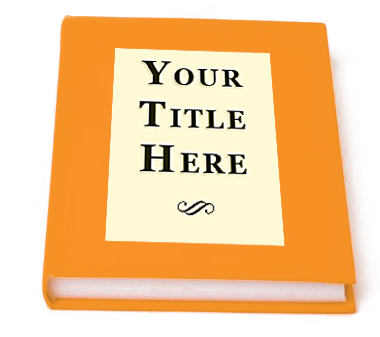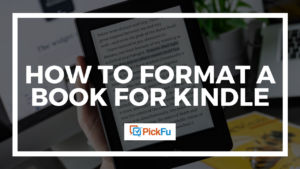A book’s title is its calling card. It’s how a potential reader finds your book. It’s how a satisfied reader talks about it to a friend.
So when it’s time to dream up a book title, what must you consider? We turned to five experts on the topic, who shared these tips:
Word of mouth
Word of mouth is still the number one reason readers buy books. If you want to maximize your sales and earnings as an author, you need to understand the word-of-mouth sales process. It all starts with your book title.
Every word of mouth sales process has three simple steps:
1. Memory
Your reader or fan must fall in love with your book and remember the book title so they can…
2. Share it
When a reader shares the title of your book with someone else online or in a conversation, they have to be able to not only remember the title of your book, but also be able to share it with others. After that, your new potential reader must be able to…
3. Find it
This is where a new potential reader goes online and searches for your book so they can buy it.
This whole process sounds really simple, but if any part of the process breaks down, you lose the sale.
If your readers can’t remember the title of your book because it’s long, confusing, or boring, they won’t be able to effectively share it with others.
If your book title is filled with homophones or archaic words, regular folks without a lot of time to waste and an Oxford dictionary on hand won’t be able to understand the title of your book, and they won’t be able to find your book either.
If a new potential reader types in the title of your book in Google or on Amazon and don’t see it in the search results, they won’t be able to find your book.
So, if you want to maximize word of mouth sales, it’s pretty simple: choose a book title that is memorable, repeatable, and searchable. Choose a title that doesn’t have homophones, archaic words, or confusing language.
– Tom Corson-Knowles
Tom Corson-Knowles is the internationally bestselling author of The Kindle Publishing Bible. Tom is also the founder of EBookPublishingSchool.com, a free self-publishing training course for authors, and TCK Publishing, an independent book publisher specializing in publishing and marketing ebooks, print books and sell audiobooks online.
Stand out
1. Do your research into the title — then stay away from “the pack”
Writing minds often think alike. I recently read a mystery entitled The Black Widow. I was talking about the book to a colleague but couldn’t remember the author’s name, so I went to Amazon.com to prompt me. Well, there are an awful lot of mysteries with some version of “black widow” in the title and many came up in search ahead of the one I’d read, which was by Wendy Corsi Staub. Staub is a bestselling author, and that book took a few minutes to locate — even when I knew what I was looking for. If you’re just starting out as an author or still trying to build an audience, a unique title will help distinguish you.
2. Use keywords, if possible
There are many factors involved in naming a book, but for non-fiction, having your important keywords in the title makes for better SEO.
3. “Front-load” the unique title
There’s a character limit on book inventory management systems, which sometimes truncates the book title. If your book is one of a series, make sure to put the title first. For example, say you’re writing a “men in uniform” romance series. You want Foot Soldier of Passion: Book 1 of The Heartfelt Uniform Trilogy vs. The Heartfelt Uniform Trilogy Book 1: Foot Soldier of Passion. In the latter case, the last part of the title might be cut off, making it harder for the store clerk to figure it out if, say, your potential buyer only remembers “foot soldier.”
4. Make it easy to pronounce
If at all possible, stay away from foreign words that aren’t already in the vernacular. Many people are shy about saying words they can’t pronounce and you really want to limit or eliminate any barrier to a potential reader asking for — or talking up — your book.
– Valerie Peterson
The author of four books (and counting), for fifteen years, Valerie directed marketing departments for major book publishers. Over the course of her career, she has managed, touched and/or had a front-row-seat to nearly every part of the book publishing process — she understands the business side of book publishing and its “peculiarities.”
ValeriePeterson.net
Be inclusive
Don’t try to be clever and come up with a title that has meaning that is hidden until the book is read. The title is not for someone who has already read the book – it’s there to entice someone to buy. It should speak clearly about the genre, preferably one of the words in the title (maybe the only word) should clearly identify its subject matter. So using words like ‘assassin’, ‘murder’, ‘love’, ‘conspiracy’, ‘countdown’ etc can instantly convey the book’s content. The title then starts to work as a sales tool. It’s hard of course, because you’ve poured your heart and soul into the book and you want a brilliant title that uses a clever play on words to subtly hint at the exciting denouement…however the reality is that a clunky title that screams ‘THRILLER’ is better for you. After all the reader will only appreciate the clever play on words AFTER they’ve bought and read the book.
– Mark Dawson
Mark Dawson is an Amazon, US Today and Barnes & Noble best-selling author. He writes two thriller series, John Milton and Beatrix Rose as well as a Soho Noir series. In addition Mark has developed best-selling online courses for independent authors, Facebook Ads for Authors and Self Publishing 101.
SelfPublishingFormula.com
Use keywords
You can either write the book title based on keywords, or on branding and creativity. It’s really up to you.
I do recommend putting keywords in your main book title when it is a natural fit. Otherwise, you can put keywords in your subtitle.
What are keywords? Keywords are phrases people use to search on Google or Amazon for your topic. Therefore, I recommend doing keyword research on both Google and Amazon.
For Google, you can use their keyword planner tool. It is free to use, and a good way to see which keywords people are searching for the most on Google. You will need to sign up for a free Google Adwords account to use it: https://adwords.google.com/KeywordPlanner
For Amazon, I recommend using the paid tool, Kindle Samurai. It will give you a lot of helpful information on keywords potential readers are using on Amazon. You can also use Amazon’s search bar to manually find keywords.
My husband is the resident “branding expert,” and he helped me come up many of my creative book titles. However, when I use a creative title, I usually include keywords in my subtitle.
For my book, Self-Publishing Books 101, I decided to put my keyword phrase “self-publishing books” in the main title instead. If you want to rank well on Amazon and/or Google for a certain keyword, it is best to also include that keyword in your main book title. It is really up to you.
– Shelley Hitz
As an author coach, book marketing strategist, and Christian entrepreneur; Shelley Hitz is on a mission to help you reach more people with your message. She has coached thousands of authors through her books, training programs, online events, seminars, and more.
Hire a designer
A great cover can be the secret sauce that gives a book the oomph it needs to get discovered. But how do you get there?
I never recommend authors create their own covers. Never. Your book must look as professional and polished as those created by pros — so hire a graphic designer. It’s worth the effort. If you’re strapped for cash, try 99Designs or Crowdsource. There are plenty of talented designers looking for work.
And once you’ve settled on a designer, learn to speak her language. In my experience, you can talk to a designer all day, but unless you show her samples of what you like, she will seem deaf as a post. Designers are right-brain people: they understand images. So go onto Amazon and find some covers you like. Use an app such as Grab to take a digital picture of your favorites, and prepare a creative brief for your designer, explaining what you like about each cover.
Here are some things you might discuss:
1. Show your designer the color palettes you like. Note: I didn’t say “colors”; I said “color palettes.” You want to choose a palette with several colors that go together and that capture the mood of your book. You’ve written a thriller? Maybe dark colors. A business book? Maybe jewel tones. Stay away from white covers, which look terrific in a busy bookstore, but which disappear into the background on the Amazon page.
2. Decide whether you want the dominant element on your cover to be type (common for business books) or images (photos or graphics). Even when creating a cover that’s primarily type, look for small spot images or graphics you can use to suggest something about the content of your book.
3. Often, an image that captures your book is hard to find. Check what your competitors have done. Then peruse iStockphoto or another stock house to see what’s possible. For a fee, your designer will do a photo search for you, and frequently she will come up with a better idea than yours. She also knows how to manipulate photos, which can produce powerful and unique covers.
4. Find fonts you love and show them to your designer, but let her choose the fonts to use. Poor font choice is the most common error I see in self-published books.
5. Make your title big, because it’s going to appear postage-stamp size on the Amazon page, your primary selling location. Check to make sure it’s still readable in that small size.
6. Pay attention to the back cover, too. It should have a short descriptive paragraph about your book, a bio, and your (professionally produced) photo. People want to see who wrote this book. Also, a barcode is necessary, and your publishing imprint with the city, state, and website are helpful.
7. If you have testimonials, add a few at the top of the back cover. If you have a great one from a crackerjack reviewer, put that one at the top of your front cover. All the rest can go on the very first page of the book.
– Holly Brady
Holly Brady, former director of the Stanford University Publishing Course, works with serious writers who want to self-publish their books.
HollyBrady.com
Check out these posts for more tips on titling your book:
• From Working Title to Title That Works
• You’re Not Always Right: How to Succeed on Amazon
• How a Book Title Impacted Performance by 400%

 – Tom Corson-Knowles
– Tom Corson-Knowles – Valerie Peterson
– Valerie Peterson – Mark Dawson
– Mark Dawson
 Holly Brady, former director of the Stanford University Publishing Course, works with serious writers who want to self-publish their books.
Holly Brady, former director of the Stanford University Publishing Course, works with serious writers who want to self-publish their books. 

